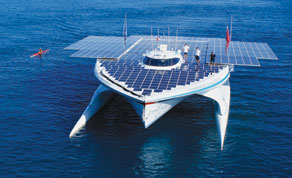 |
| An aerial file photo of the boat giving a clear view of the solar panels |
The world’s largest solar-powered boat has arrived in Doha.MS Turanor PlanetSolar, the future of fossil fuel-free marine travel, is on a global tour and is in Doha as a guest of QSTec, a Qatar-based solar grade polysilicon company.
“We are excited to see this breakthrough, once a dream, which has become a reality,” QSTec board member and CEO Dr Khalid Klefeekh al-Hajri said yesterday while welcoming the PlanetSolar team at The Pearl-Qatar marina.
The arrival of PlanetSolar in Doha strengthens QSTec’s resolve to develop products that will enable the creation of new and innovative uses for solar technologies to help protect the environment, he said.
The German-built prototype craft, powered by 537sqm of photovoltaic cells spread across the top deck, started its voyage on September 27, 2010 in Monaco and follows a route close to the equator. It is scheduled to conclude its trip back in Monaco in May 2012.
 |
|
Dr al-Hajri, Stroher and Domjan |
The objective is to demonstrate to the world the potential of renewable energies and the availability of technologies required for sustainability, he explained.
The boat’s owner, German businessman Immo Stroher who funded the $25mn project, and crew members Erwann Le Rouzic, Jens Langwasser, Christian Ochsenbein, Thomas David and Oliver Goldenbow were present on the occasion.
Solar energy, produced from 38,000 solar cells and stored in six massive lithium ion batteries weighing a total of 11 tonnes, is also used to power the onboard refrigerator, freezer, lights, computers, water heater and audio-video equipment.
“With fully charged batteries we can go on for three days,” Rouzic, a French national and professional sailor, who is the captain of PlanetSolar told Gulf Times during a tour of the deck.
Each crewmember does a three-hour shift on watch. Part of the energy produced by the solar panels goes to the propellers and the rest to the batteries, which are stored three each in either hull.
“During winter in this region the batteries get fully charged in three days and in summer it requires just one-and-a-half day,” Rouzic said.
PlanetSolar consumes 20 to 30% energy from batteries during night. From the team’s experience over the past 15 months at sea, the captain said cloudy days are good enough for solar power generation.
“We have found that dust has no impact on the efficiency of the photovoltaic panels, but bird droppings have,” he added.
The solar cells, made by SunPower California, have been made into panels in Germany. “These cells are commercially available in the market,” said project manager Jens Langwasser, who is also head of the construction team of PlanetSolar, which needed 65,000 man-hours.
The solar cells are protected by an innovative encapsulation system which involves a layer of glass placed on the panels, for greater resistance as well as for maximum transparency, and a layer of lighter composite materials below.
“Only the kitchen operates with gas,” said Dutchman Goldenbow, who doubles as the cook and photographer.
The ‘crazy idea’ of circumnavigating the globe aboard a vessel powered only by solar energy originated in 2004 in the mind of Swiss national Domjan who has worn several hats, including those of an ambulance driver, a high mountain guide and a rescue specialist in perilous environments.
The concept became a reality after a meeting in February 2008 with Stroher, who is passionate about solar technologies. The double hull carbon fibre boat was built in 18 months in Kiel, Germany.
It weighs 85 tonnes, is 31m long and 15m wide. The length and width increases to 35m and 23m, respectively, when the solar panel ‘wings’ to the sides and rear are deployed.
There are two engines per propulsion system, comprising one engine with 40kW and one with 20kW. The solar panels produce 93.5kW (127hp) and average engine consumption is 20kW (26.8hp).
“Our average speed is five knots (9kmph) and the top speed is 10 knots,” Domjan said adding that a conventional boat of the same size would be a little faster.
PlanetSolar was originally designed to be faster. “But we decided to make it safer, so it became heavier,” Stroher said.
The boat, which arrived in Doha from Mumbai after a two-week voyage, will remain berthed at The Pearl-Qatar marina for three weeks, during which the crew will fly home for Christmas and New Year celebrations.


